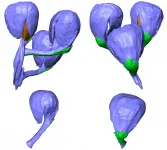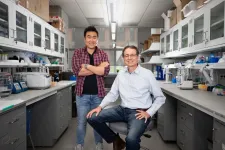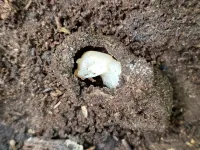(Press-News.org) What explains how often people travel to a particular place? Your intuition might suggest that distance is a key factor, but empirical evidence can help urban studies researchers answer the question more definitively.
A new paper by an MIT team, drawing on global data, finds that people visit places more frequently when they have to travel shorter distances to get there.
"What we have found is that there is a very clear inverse relationship between how far you go and how frequently you go there," says Paolo Santi, a research scientist at the Senseable City Lab at MIT and a co-author of the new paper. "You only seldom go to faraway places, and usually you tend to visit places close to you more often. It tells us how we organize our lives."
By examining cellphone data on four continents, the researchers were able to arrive at a distinctive new finding in the urban studies literature.
"We might shop every day at a bakery a few hundred meters away, but we'll only go once a month to the fancy boutique miles away from our neighborhood. This kind of intuitive notion had never been empirically tested. When we did it we found an incredibly regular and robust law -- which we have called the visitation law," says Carlo Ratti, a co-author of the paper and director of the Senseable City Lab, which led the research project.
The paper, "The universal visitation law of human mobility," is published today in Nature.
The paper is co-authored by Markus Schläpfer, a scholar in the Urban Complexity Project at the ETH Future Cities Lab in Singapore; Lei Dong, a researcher at Peking University in Beijing; Kevin O'Keeffe, a postdoc at the MIT Senseable City Lab; Santi, a research director at Istituto di Informatica e Telematica, CNR (the National Research Council of Italy); Michael Szell, an associate professor in Data Science at IT University of Copenhagen; Hadrien Salat of the Future Cities Laboratory, Singapore-ETH Centre; Samuel Anklesaria, a researcher at the MIT Senseable City Lab; Mohammad Vazifeh, a senior postdoc at the MIT Senseable City Lab; Ratti; and Geoffrey West, a professor at and former president of the Santa Fe Institute. Schläpfer, Dong, Santi, and Szell are also former members of the Senseable City Lab.
To conduct the study, the researchers used anonymized cellphone data from large communications providers to track the movement of people in the metro areas of Abidjan, Ivory Coast; Boston; Braga, Lisbon, and Porto, Portugal; Dakar, Senegal; and Singapore.
Cellphone data are ideal for this kind of study because they establish both the residence area of people and the destinations they travel to. In some cases, the researchers defined areas visited by using grid spaces as small as 500 square meters. Overall, the researchers charted over 8 billion location-indicating pieces of data generated by over 4 million people, charting movement for a period of months in each location.
And, in each case, from city to city, the same "inverse law" of visitation held up, with the charted data following a similar pattern: The frequency of visits declined over longer distances, and higher-density areas were filled with people who had, on aggregate, taken shorter trips. To the extent that there was some variation from this pattern, the largest deviations involved sites with atypical functions, such as ports and theme parks.
The paper itself both measures the data and presents a model of movement, in which people seek out the closest locations that offer particular kinds of activity. Both of those buttress "central place theory," an idea developed in the 1930s by German scholar Walter Christaller, which seeks to describe the location of cities and towns in terms of the functions they offer to people in a region.
The scholars note that the similarity in movement observed in very different urban areas helps reinforce the overall finding.
"This generalized behavior is not just something you observe in Boston," Santi says. "From a scientific viewpoint, we are adding evidence about a generalized pattern of behavior."
The researchers also hope the finding, and the methods behind it, can be usefully applied to urban planning. Santi suggests this type of study can help predict how substantial changes in the physical layout of a city will affect movement within it. The method also makes it possible to examine how changes in urban geography affect human movement over time.
"The visitation law could have many practical applications -- from the design of new infrastructure to urban planning," adds Ratti. "For instance, it could help implement the concept of the 'Fifteen-Minute City,' which aims to reorganize physical space around walkable neighborhoods and which has become very popular during the Covid-19 pandemic. Our law suggests that we can indeed capture a large fraction of all urban trips within a fifteen-minute radius, while leaving the rest -- perhaps 10 percent -- further away."
INFORMATION:
Support for the research was provided by the National Science Foundation, the AT&T Foundation, the Singapore-MIT Alliance for Research and Technology (SMART), the MIT Center for Complex Engineering Systems, Audi Volkswagen, BBVA, Ericsson, Ferrovial, GE, the MIT Senseable City Lab Consortium, the John Templeton Foundation, the Eugene and Clare Thaw Charitable Trust, the U.S. Army Research Office Minerva program, the Singapore National Research Foundation, and the National Natural Science Foundation of China.
Written by Peter Dizikes, MIT News Office
What The Study Did: Researchers analyzed each state's department of health website for accessibility and usability challenges. Findings suggest state health department COVID-19 vaccine website accessibility and usability challenges create frustration, may promote health disparities and contribute to overall ineffective and inequitable distribution.
Authors: Raj M. Ratwani, Ph.D., of the Medstar Health National Center for Human Factors in Healthcare in Washington, D.C., is the corresponding author.
To access the embargoed study: Visit our For The Media website at this link https://media.jamanetwork.com/
(doi:10.1001/jamanetworkopen.2021.14861)
Editor's ...
Seeing, hearing, thinking, daydreaming -- doing anything at all, in fact -- activates neurons in the brain. But for people predisposed to developing brain tumors, the ordinary buzzing of their brains could be a problem. A study by researchers at Washington University School of Medicine in St. Louis and Stanford University School of Medicine shows that the normal day-to-day activity of neurons can drive the formation and growth of brain tumors.
The researchers studied mice genetically prone to developing tumors of their optic nerves, the bundle of neurons that carries ...
What The Study Did: Researchers quantified the added burden of fatal opioid overdoses occurring in Ontario, Canada, during the first six months of the COVID-19 pandemic.
Authors: Tara Gomes, Ph.D., of the Keenan Research Centre of the Li Ka Shing Knowledge Institute, St. Michael's Hospital in Toronto, is the corresponding author.
To access the embargoed study: Visit our For The Media website at this link https://media.jamanetwork.com/
(doi:10.1001/jamanetworkopen.2021.12865)
Editor's Note: The article includes conflict of interest and funding support disclosures. ...
What The Study Did: Researchers compared reporting practices for race, sex and socioeconomic status in randomized clinical trials published in general medical journals in 2015 with those published in 2019.
Authors: Asad Siddiqui, M.D., of the Hospital for Sick Children in Toronto, is the corresponding author.
To access the embargoed study: Visit our For The Media website at this link https://media.jamanetwork.com/
(doi:10.1001/jamanetworkopen.2021.11516)
Editor's Note: Please see the article for additional information, including other authors, author contributions and affiliations, conflict of interest and financial disclosures, and funding and support.
INFORMATION:
Media advisory: The full study is linked to this news ...
Flowering plants (angiosperms) dominate most terrestrial ecosystems, providing the bulk of human food. However, their origin has been a mystery since the earliest days of evolutionary thought.
Angiosperm flowers are hugely diverse. The key to clarifying the origin of flowers and how angiosperms might be related to other kinds of plants is understanding the evolution of the parts of the flower, especially angiosperm seeds and the fruits in which the seeds develop.
Fossil seed-bearing structures preserved in a newly discovered Early Cretaceous silicified peat in Inner Mongolia, China, provide a partial answer to the origin of flowering plants, according to a study led by Prof. SHI Gongle from the Nanjing ...
LEXINGTON, Ky. (May 26, 2021) - Using novel imaging methods for studying brain metabolism, University of Kentucky researchers have identified the reservoir for a necessary sugar in the brain. Glycogen serves as a storage depot for the sugar glucose. The laboratories of Ramon Sun, Ph.D., assistant professor of neuroscience, Markey Cancer Center at the University of Kentucky College of Medicine, and Matthew Gentry, Ph.D., professor of molecular and cellular biochemistry and director of the Lafora Epilepsy Cure Initiative at the University of Kentucky College ...
Berkeley -- The lifestyle of the horned passalus beetle, commonly known as the bessbug or betsy beetle, might seem downright disgusting to the average human: Not only does this shiny black beetle eat its own poop, known as frass, but it uses its feces to line the walls of its living space and to help build protective chambers around its developing young.
Gross as it may seem, a new study suggests that this beetle's frass habits are actually part of a clever strategy for protecting the insect's health -- and could help inform human medicine, too.
Researchers at the University of California, Berkeley, have discovered that the frass of the horned passalus beetle is teeming with antibiotic and antifungal chemicals similar to the ones that humans use to ward off bacterial and ...
In a new study published online in spring 2021 and in the July issue of the journal Contraception, University of Chicago Medicine investigators and colleagues interviewed primary care providers in Illinois about their interest in providing medication abortion care and found that lifting FDA restrictions on mifepristone to allow pharmacy dispensing could normalize medication abortion, facilitate its use in primary care facilities, and address disparities in reproductive health access.
"Mifepristone is used in combination with misoprostol to end early pregnancies, during the first trimester," ...
COLUMBUS, Ohio - Thermoelectric power generators that make electrical power from waste heat would be a useful tool to reduce greenhouse gas emissions if it weren't for a most vexing problem: the need to make electrical contacts to their hot side, which is often just too hot for materials that can generate a current.
The heat causes devices to fail over time.
Devices known as transverse thermoelectrics avoid this problem by producing a current that runs perpendicular to the conducting device, requiring contacts only on the cold end of the generator. Though considered a promising ...
DURHAM, N.H.--Researchers at the University of New Hampshire have conducted two of the first studies in New England to collectively show that toxic man-made chemicals called PFAS (per-and polyfluoroalkyl substances), found in everything from rugs to product packaging, end up in the environment differently after being processed through wastewater treatment facilities--making it more challenging to set acceptable screening levels.
"PFAS are persistent substances that are not easily broken down and have been linked to adverse health effects," said Paula Mouser, associate professor of civil and environmental engineering. "They are found in a wide variety of industrial, commercial and medicinal products and can end up in the body, human waste and the environment. If not managed correctly, they ...



